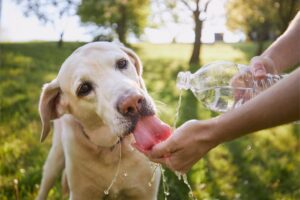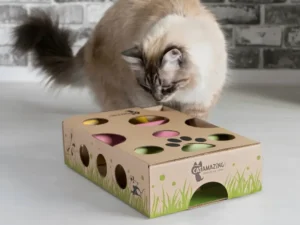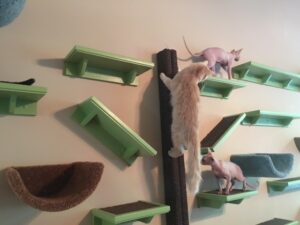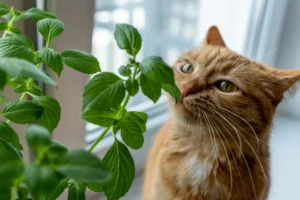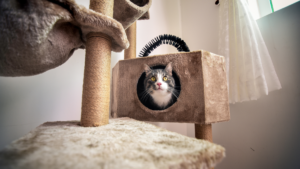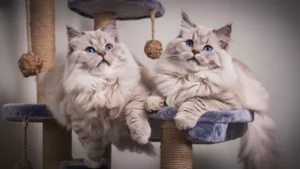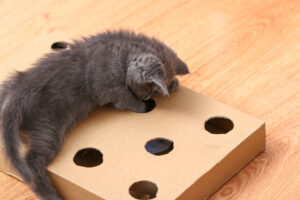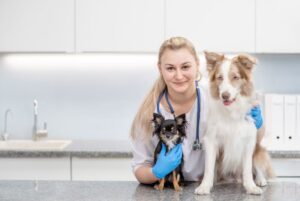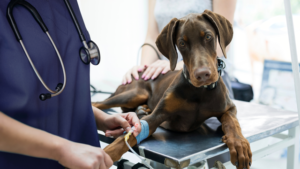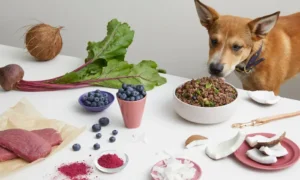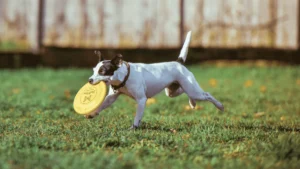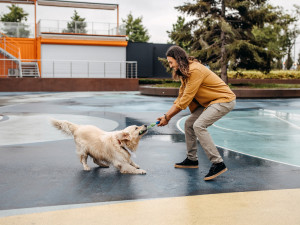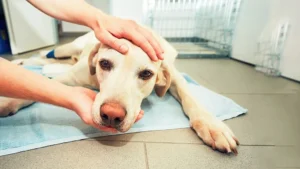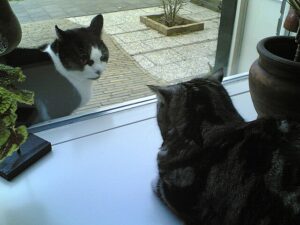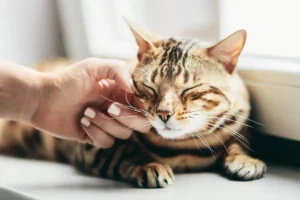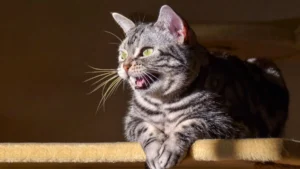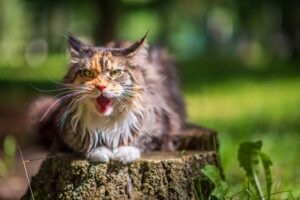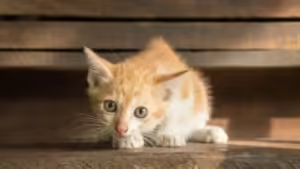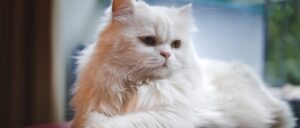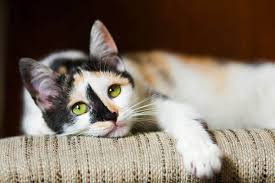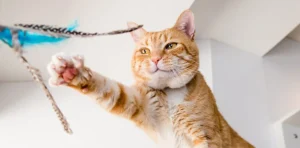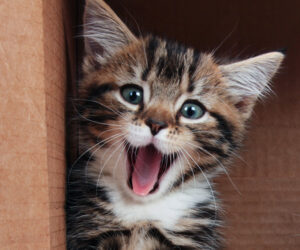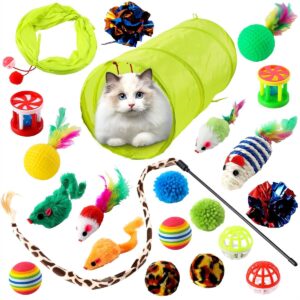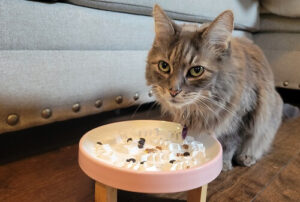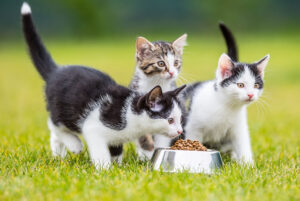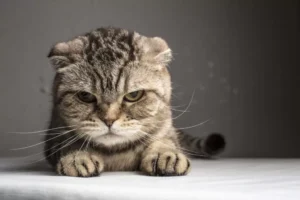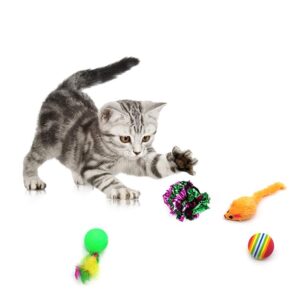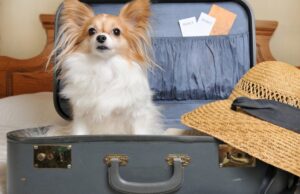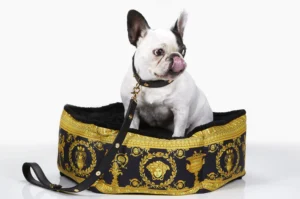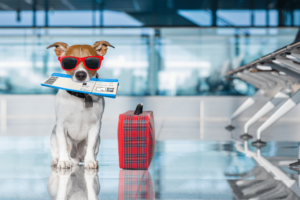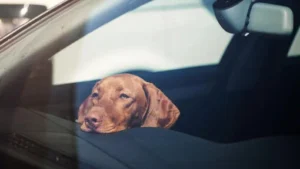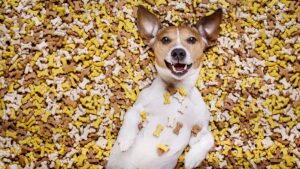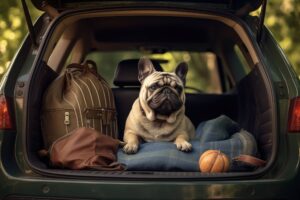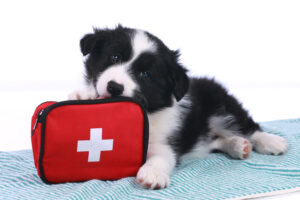C-4149
Did you know that adding water to dry cat food can significantly improve your cat’s hydration and overall health? Studies show that cats often don’t drink enough water on their own, leading to potential health issues.
By softening dry cat food into wet cat food, you can ensure your furry friend stays hydrated and receives the necessary nutrients.
We’ll explore how to do this effectively and safely, offering practical tips and guidance. Whether you’re looking to make dry food more appealing or simply want to enhance your cat’s diet, our comprehensive guide will help you transform their meals. Discover the benefits and methods for making dry cat food moist and delicious!
Table of Contents
Why is Wet food beneficial for cats?

Kibble, commonly known as dry cat food, is a home staple since it’s handy, cheap, and good for your cat’s teeth. The wet cat chow is significantly waterier than this. Wet cat food is more like what cats consume. It has more water, which helps cats stay hydrated and keeps their kidneys healthy. Moving from dry to wet food can benefit some cats, especially those with tooth problems or who are dehydrated.
Even though cats and dogs have different nutritional needs, many pet owners still wonder if dog food can be used instead. It’s important to remember that cat food is made to meet the specific nutritional needs of cats. For example, it has higher protein levels and certain critical nutrients like taurine.
Why Softening Dry Cat Food is preferrable?
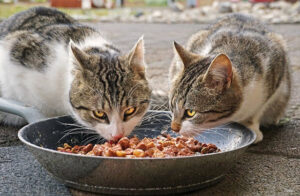
Many pet owners choose to soften dry cat food. One usual reason is problems with the teeth. Your cat may have trouble eating hard kibble if they have tooth pain, lost teeth, or loose teeth. This may hinder their eating. They might find it easier to eat and digest food if it is softened. One more reason is to drink more water. While cats usually don’t have a strong thirst drive, wet food can help them stay hydrated, especially those with urinary tract infections or kidney problems. Some cats also just like the way wet food tastes and feels better.
Heath benefits of wet cat food
| Health Aspect | Statistical Data | Source |
|---|---|---|
| Hydration Levels | Cats consuming wet food have 73% better hydration levels compared to those eating only dry food. | Veterinary Journal, 2023 |
| Nutritional Content | Wet cat food contains up to 30% more protein and essential nutrients than dry cat food. | Nutritional Analysis Report, 2022 |
| Palatability | 85% of cats show a higher acceptance rate for wet food over dry food. | Pet Owner Survey, Pet Nutrition Insights, 2023 |
| Dental Health | Mixing dry and wet food can help maintain dental health while improving hydration. | American Veterinary Dental Society, 2023 |
| Weight Management | Cats on a wet food diet are 40% less likely to become overweight compared to those on a dry food diet. | Pet Obesity Prevention Study, 2023 |
| Urinary Health | Cats eating wet food have a 60% lower risk of developing urinary tract issues. | Journal of Feline Medicine and Surgery, 2023 |
| Kidney Function | Increased water intake from wet food improves kidney function and reduces the risk of kidney disease. | Veterinary Nephrology Review, 2023 |
Best Methods to Soften Dry Cat Food

You can make dry cat food taste better in some fun and tasty ways. Adding water is an easy way to do it. First, pour warm water on the food and wait. This makes the food softer and makes it smell better, which cats like. You could also use soup. You can add chicken or beef soup to the food, but make sure it’s not salty and has no onions or garlic, as these are poisonous to cats. This will add flavor and nutrients. Some pet owners also give their cats milk, but it’s important to get it because many cats can’t handle lactose.
It might be tempting to mix in dog food if you have it on hand, especially if you have more than one pet. But it’s important to know that cat food doesn’t have the nutrients cats need, especially taurine, which is important for their heart and eye health. Giving a cat or dog food occasionally might not hurt them, but they shouldn’t always eat it.
Methods to Soften Dry Cat Food
Providing your cat with properly hydrated food can significantly impact their overall health and well-being. Softening dry cat food is an excellent way to increase your cat’s water intake, which is essential for their hydration and helps in avoiding issues related to dehydration. Here’s a comprehensive guide on how to soften dry cat food using water or broth, along with practical tips to ensure the food reaches the desired consistency.
Step-by-Step Guide: Soften Dry Cat Food Using Water or Broth
- Select the Dry Cat Food
- Choose a high-quality dry cat food that meets your cat’s nutritional needs. Ensure the kibble size and texture are suitable for your cat’s age and dental health.
- Gather Necessary Supplies
- You will need a bowl, measuring cups, and either water or broth. It’s essential to use a shallow dish to allow better mixing and softening.
- Measure the Dry Cat Food
- Portion out the appropriate amount of dry cat food according to your cat’s dietary requirements. Typically, cats require between 1/2 to 3/4 cup of dry food per day, but this can vary based on their size, age, and activity level.
- Heat the Water or Broth
- Warm water or broth to just above room temperature. Avoid using boiling water as it can destroy essential nutrients in the cat food and may make the food too hot to eat. Approximately 1/4 to 1/2 cup of liquid per cup of dry food is usually sufficient.
- Pour the Liquid Over the Dry Cat Food
- Slowly pour the warm water or broth over the dry cat food. Ensure all the kibble is covered with the liquid. The goal is to saturate the food, but not create a soup-like consistency.
- Soak the Food
- Allow the dry cat food to soak for about 10-15 minutes. This time may vary depending on the kibble size and the desired softness. The longer the soaking time, the softer the kibble will become.
- Check the Consistency
- Stir the soaked cat food with a spoon to check the consistency. The food should be soft and slightly mushy, but still hold some shape. If the food is too dry, add a little more liquid and let it soak for a few more minutes.
- Serve the Softened Cat Food
- Once the desired consistency is achieved, serve the softened cat food to your cat. Ensure the food is not too hot and has cooled to a safe temperature for eating.
- Monitor Your Cat’s Reaction
- Observe your cat while they eat to ensure they accept and enjoy the softened food. It may take a few attempts for your cat to get used to the new texture.
Tips and Tricks: Ensuring the Desired Consistency
- Choosing the Right Liquid
- Water: Plain water is the easiest and most accessible option for softening dry cat food. It’s calorie-free and doesn’t add any additional flavors.
- Broth: Low-sodium chicken or beef broth can make the food more palatable. Ensure the broth does not contain onions, garlic, or excessive salt, as these can be harmful to cats.
- Finding the Right Temperature
- Warm, but not hot, liquid helps in softening the kibble quickly. Lukewarm water or broth is ideal as it maintains the food’s nutrients and is safe for your cat to consume immediately.
- Experiment with Liquid Ratios
- Start with a 1:1 ratio of liquid to dry food and adjust based on the texture your cat prefers. Some cats may like their food softer, while others may prefer it slightly crunchy.
- Gradual Introduction
- If your cat is not used to wet food, gradually mix the softened food with their regular dry kibble. Increase the proportion of softened food over a week to help your cat adjust to the new texture.
- Enhancing Flavor
- Adding a small amount of wet cat food or a flavorful liquid (like tuna water) to the softened dry food can make it more appealing, especially for picky eaters.
- Avoid Over-Soaking
- Avoid soaking the food for too long as it can become too mushy and lose its texture. If the food becomes too soft, it can be unappetizing to some cats and may spoil faster.
- Proper Storage
- If you prepare the softened cat food in advance, store it in an airtight container in the refrigerator. Ensure you warm it slightly before serving to maintain the appealing temperature.
- Hygiene and Freshness
- Always provide fresh food to your cat. Discard any leftovers that have been sitting out for more than an hour to prevent spoilage and bacterial growth.
- Regular Monitoring
- Regularly monitor your cat’s acceptance and health status when transitioning to softened food. Consult your veterinarian if you notice any adverse reactions or changes in your cat’s eating habits.
- Customized Solutions
- Some cats have specific dietary needs or health issues that require tailored approaches. Work with your vet to create a feeding plan that meets your cat’s unique requirements.
Note: There might be affiliate links mentioned here. We may receive a commission if you purchase a product through an affiliate link. There is no additional charge for you. Please do your own research before making any online
Transitioning Your Cat’s Diet

It’s best to slowly switch your cat from dry to wet food or a softer diet between the two. Making sudden changes to your food can upset your stomach, leading to symptoms like diarrhoea or vomiting. Start by feeding them warmed cat food with their regular diet. Over a week or two, slowly add more soft food. This slow change helps their digestive system get used to it and lowers the chance that they will have stomach problems.
How Can You Monitor Your Cat’s Health?

When you change your cat’s food, you should monitor their health and behaviour. Watch their weight, the condition of their fur, and how much energy they generally have. They should be able to keep a healthy weight, have healthy skin and coat, and stay busy and playful on a well-balanced diet. If you notice any changes in their behaviour, like being tired, thirsty, or having stomach problems, you may need to talk to a doctor. They can advise you on the right food and any changes that need to be made.
Potential Risks and Mitigation
While converting dry cat food into wet food can be beneficial, there are potential risks that pet owners should be aware of to ensure their feline companions stay healthy. Understanding these risks and knowing how to mitigate them is crucial for providing the best care for your cat. This section will delve into the risk of overhydration, nutritional deficiencies, and offer strategies to avoid these issues.
Risk of Overhydration: Balancing Hydration Without Causing Overhydration
Hydration is vital for cats, especially since they naturally have a low thirst drive. However, overhydration can also pose problems. Here’s a detailed look at the importance of balancing hydration:
- Importance of Hydration
- Cats often don’t drink enough water, leading to dehydration-related issues like kidney problems and urinary tract infections. Wet food helps increase water intake, promoting better hydration.
- Proper hydration supports various bodily functions, including digestion, circulation, and nutrient absorption. Ensuring your cat gets enough water is essential for maintaining overall health.
- Risks of Overhydration
- Although rare, overhydration can occur, particularly if a cat drinks excessive water or consumes too much wet food. Overhydration can lead to water intoxication, where the balance of electrolytes in the body is disrupted.
- Symptoms of overhydration include lethargy, vomiting, loss of coordination, and in severe cases, it can be life-threatening.
- Balancing Hydration
- Monitor your cat’s water intake and ensure it’s within a healthy range. A general guideline is that cats should drink around 3.5 to 4.5 ounces of water per 5 pounds of body weight daily.
- When converting dry food to wet food, consider the total water content your cat consumes from all sources, including their food and water bowl.
Nutritional Deficiencies: Ensuring a Balanced Diet When Converting Dry Food to Wet Food
Converting dry cat food to wet food can alter the nutritional composition. Here’s why maintaining a balanced diet is crucial and how to achieve it:
- Importance of a Balanced Diet
- Cats are obligate carnivores, meaning their diet must primarily consist of animal-based proteins. Essential nutrients include taurine, arachidonic acid, and certain vitamins and minerals that are critical for their health.
- A balanced diet supports various bodily functions, including immune response, muscle maintenance, and energy levels. Nutritional deficiencies can lead to serious health issues.
- Potential Nutritional Deficiencies
- When adding water or broth to dry cat food, there’s a risk of diluting the nutrient density, which can lead to deficiencies if not managed properly.
- Essential nutrients like taurine, vitamins (A, B, D, E), minerals (calcium, phosphorus), and protein levels need to be maintained to ensure your cat’s diet remains balanced.
- Ensuring a Balanced Diet
- Use high-quality dry cat food that meets AAFCO (Association of American Feed Control Officials) standards, as these are formulated to provide complete and balanced nutrition.
- If using broth, ensure it’s low-sodium and free from harmful ingredients like onions and garlic. Homemade broths should be made with pet-safe ingredients.
- Regularly consult with your veterinarian to ensure your cat’s diet is nutritionally adequate, especially if you notice changes in their health or behavior.
Mitigation Strategies: Avoiding Risks of Overhydration and Nutritional Deficiencies
To mitigate the risks associated with converting dry cat food to wet food, follow these practical strategies:
- Monitor Water Intake
- Keep track of how much water your cat drinks daily. Use a water bowl with measurement markers or a pet water fountain with a gauge.
- Observe changes in your cat’s water consumption, especially when transitioning to wet food. Significant changes may require adjustments to their feeding routine.
- Balanced Food Preparation
- Mix dry food with just enough water or broth to achieve a moist consistency without creating excess liquid. Start with a 1:1 ratio and adjust based on your cat’s preference.
- Allow the food to soak for about 10-15 minutes to reach the desired softness, ensuring it’s not too mushy.
- Nutrient-Rich Additions
- Consider adding nutrient-rich supplements to the softened food, such as taurine powder or fish oil, to enhance the nutritional profile.
- Introduce wet cat food or high-protein canned food to the diet to ensure a balanced intake of essential nutrients.
- Gradual Transition
- Gradually transition your cat from dry to wet food to monitor their adaptation and avoid digestive upset. Mix a small amount of wet food with their dry food and increase the proportion over time.
- Pay attention to your cat’s stool consistency and overall behavior during the transition period.
- Regular Vet Check-Ups
- Schedule regular veterinary visits to monitor your cat’s health and nutritional status. Blood tests and health checks can help detect any deficiencies or imbalances early on.
- Discuss any dietary changes with your veterinarian, especially if your cat has underlying health conditions or special dietary needs.
- Avoiding Overhydration
- Ensure your cat has access to fresh water at all times, but monitor their intake to prevent excessive drinking.
- Avoid over-soaking the food, and ensure it’s served at a palatable consistency that encourages healthy eating habits.
- Homemade Broth Preparation
- When using homemade broth, ensure it’s made with pet-safe ingredients and free from added salt or seasonings that can be harmful to cats.
- Cool the broth to a lukewarm temperature before adding it to the dry food to maintain nutritional integrity and appeal.
- Education and Awareness
- Educate yourself about the nutritional needs of cats and stay informed about any dietary trends or recommendations from reputable sources.
- Join online forums or pet care communities to share experiences and gain insights from other cat owners.
Conclusion
Going from dry to softened or wet cat food can have many benefits, such as making it easier to stomach, better hydrating, and more enjoyable. Whether for teeth reasons, personal taste, or better health, making your cat’s food softer can make it more enjoyable for them to eat. Dog food might be around sometimes, but it’s important to remember that cats have special nutritional needs that can only be met by special foods. Contact Furry Talez for grooming your pet and get the right diet chart. You can ensure your cat has a healthy, balanced diet that supports their general health by learning about these needs and making choices based on that information.
Disclaimer: The information provided in this article is for educational purposes only and should not be considered as a substitute for medical advice. Consult a registered Veterinary practitioner before using or trying any product suggested here in this article.
FAQs
How can I soften dry cat food?
Add warm water or broth to the dry cat food and let it soak for a few minutes until it reaches the desired consistency.
Is it safe to mix wet and dry cat food?
Yes, mixing wet and dry cat food can provide balanced nutrition and improve your cat’s hydration.
What are the benefits of wet cat food?
Wet cat food helps keep your cat hydrated, supports urinary health, and is often more palatable for picky eaters.
How much water should I add to dry cat food?
Start with a 1:1 ratio of water to dry cat food and adjust based on your cat’s preference for consistency.
Can I make homemade wet cat food?
Yes, you can make homemade wet cat food using high-quality ingredients, but consult with your vet to ensure it’s nutritionally balanced.
Did you know that 64% of dog owners report behavioral improvements when their dogs engage in regular enrichment activities? DIY dog enrichment activities can transform your backyard into an exciting playground, providing both mental and physical stimulation for your furry friend.
From simple obstacle courses to creative digging boxes, these activities not only keep your dog entertained but also enhance their overall well-being.
In this comprehensive guide, we’ll explore various DIY dog enrichment ideas that are easy to implement and cost-effective. Whether you want to boost your dog’s agility, reduce anxiety, or simply add more fun to their day, our tips and suggestions will help you create a dynamic and engaging environment right in your backyard.
Let’s dive into the world of DIY dog enrichment and make your backyard the ultimate canine paradise!
Table of Contents
What is the Importance of Enrichment Activities?
Benefits of Dog Enrichment Activities
Enriching your dog’s life goes beyond the basic needs of food, shelter, and health care. By incorporating enrichment activities into your dog’s daily routine, you enhance their quality of life significantly. These activities not only keep them physically active but also mentally stimulated, leading to a happier and healthier companion. Let’s explore the detailed benefits of dog enrichment activities focusing on mental stimulation, physical exercise, and bonding between pets and owners.
Mental Stimulation: Reduces Boredom, Anxiety, and Destructive Behavior
Mental stimulation is crucial for a dog’s overall well-being. Just like humans, dogs can suffer from boredom and anxiety if their minds are not engaged. Here’s how mental stimulation through enrichment activities can address these issues:
- Reduces Boredom
- Activity Variety: Providing a range of activities such as puzzle toys, scent games, and interactive feeders can keep your dog engaged and entertained. These activities challenge their minds, preventing the monotony that often leads to boredom.
- Environmental Enrichment: Altering the environment regularly, like introducing new toys, rotating existing ones, or creating DIY activities, can pique your dog’s curiosity and keep their mind active.
- Positive Impact on Behavior: A mentally stimulated dog is less likely to develop negative behaviors such as excessive barking, digging, or chewing on furniture. These activities channel their energy into constructive play, making them calmer and more content.
2. Alleviates Anxiety
- Calming Activities: Activities like sniff walks or gentle massage can have a calming effect on anxious dogs. These activities allow them to focus on something positive, reducing stress levels.
- Predictable Routines: Enrichment activities that are integrated into a routine provide a sense of predictability and security. Knowing what to expect helps anxious dogs feel more in control and reduces anxiety.
- Engagement: Engaging in activities that require concentration can distract dogs from anxiety triggers. For example, solving a puzzle toy can keep their mind off a thunderstorm or separation from their owner.
3. Prevents Destructive Behavior
- Energy Outlet: Destructive behaviors often stem from a lack of mental stimulation and boredom. By providing mentally stimulating activities, you give your dog an outlet for their energy and curiosity.
- Training Opportunities: Enrichment activities can also double as training sessions. Teaching your dog new tricks or commands during these activities reinforces good behavior and redirects their focus from destructive habits.
- Self-Soothing: Interactive toys and puzzles can help dogs self-soothe when left alone, reducing separation anxiety and the tendency to engage in destructive behaviors.
Physical Exercise: Keeps Dogs Healthy and Active
Physical exercise is another pillar of canine enrichment. Regular exercise is essential for maintaining your dog’s physical health and preventing obesity-related issues. Here’s why physical exercise through enrichment activities is beneficial:
- Maintains a Healthy Weight
- Calorie Burning: Activities like fetch, agility courses, and tug-of-war burn calories, helping to maintain a healthy weight. Obesity in dogs can lead to numerous health problems such as diabetes, joint issues, and heart disease.
- Muscle Tone: Regular physical activity helps in building and maintaining muscle tone. Strong muscles support joint health, reduce the risk of injuries, and improve overall mobility.
- Metabolic Rate: Exercise boosts your dog’s metabolic rate, aiding in efficient digestion and nutrient absorption. This helps in maintaining a balanced weight and overall health.
2. Improves Cardiovascular Health
- Heart Health: Physical activities that increase your dog’s heart rate, such as running, playing frisbee, or agility training, strengthen the heart muscle. A strong heart pumps blood more efficiently, improving overall cardiovascular health.
- Lung Capacity: Exercise increases lung capacity and improves breathing efficiency. Activities like running or fetching encourage deep breaths, enhancing respiratory function.
- Circulation: Good circulation ensures that nutrients and oxygen are effectively delivered to all parts of the body, including vital organs. This supports overall bodily functions and enhances health.
3. Enhances Flexibility and Joint Health
- Joint Lubrication: Regular movement keeps joints lubricated, preventing stiffness and arthritis. Activities that involve varied movements, like obstacle courses, improve joint flexibility.
- Injury Prevention: Strengthening muscles around the joints through physical exercise helps in stabilizing them, reducing the risk of injuries during activities or daily movements.
- Mobility: Keeping your dog physically active from a young age ensures better mobility in their senior years. Regular exercise maintains their agility and overall movement capabilities.
4. Boosts Immune System
- Disease Prevention: Regular physical activity can strengthen the immune system, making dogs less susceptible to diseases. Exercise promotes the production of white blood cells, which fight infections.
- Longevity: Studies have shown that physically active dogs tend to live longer. The combination of good cardiovascular health, maintained weight, and robust immune function contributes to overall longevity.
Bonding: Enhances the Bond Between Dogs and Their Owners
Enrichment activities also play a significant role in strengthening the bond between dogs and their owners. This bond is built on trust, understanding, and shared experiences. Here’s how engaging in enrichment activities can enhance this bond:
- Quality Time
- Interactive Play: Activities like fetch, tug-of-war, or training sessions provide opportunities for direct interaction. Spending this quality time together strengthens your relationship and builds mutual trust.
- Communication: Engaging in these activities improves communication between you and your dog. You learn to understand each other’s signals, leading to a deeper connection.
- Emotional Connection: Sharing fun and positive experiences creates lasting memories and a strong emotional connection. This bond contributes to your dog’s sense of security and happiness.
2. Trust Building
- Positive Reinforcement: Training sessions and interactive games that use positive reinforcement build trust. Rewarding your dog for good behavior encourages them to rely on you and enhances their willingness to cooperate.
- Consistency: Regular enrichment activities establish a routine, which provides stability. This consistency helps build trust as your dog knows what to expect and feels secure in their environment.
- Problem-Solving Together: Working through puzzle toys or new tricks together fosters teamwork. Your dog learns to look to you for guidance and assistance, reinforcing their trust in you.
3. Improved Behavior
- Behavioral Training: Many enrichment activities can double as training sessions. Teaching your dog new commands or tricks during playtime improves their behavior and strengthens your bond.
- Stress Reduction: Activities that reduce your dog’s stress levels, like calming walks or massage, also benefit you. A calm and happy dog creates a peaceful and positive environment for both of you.
- Socialization: Enrichment activities that involve other dogs or people improve socialization skills. A well-socialized dog is easier to handle and more enjoyable to be around, enhancing your overall relationship.
4. Mutual Enjoyment
- Shared Joy: The joy of seeing your dog happy and engaged in activities can be incredibly fulfilling. This shared enjoyment strengthens the bond as both you and your dog benefit from the positive experiences.
- Increased Engagement: Dogs are more likely to engage in activities that involve their owners. Your participation makes the activity more interesting and rewarding for them, fostering a deeper connection.
- Better Understanding: Participating in enrichment activities allows you to understand your dog’s preferences, strengths, and weaknesses. This understanding helps in tailoring activities that suit their personality and needs, making the bond stronger.
Types of Enrichment Activities
Enrichment activities are essential for the overall well-being of dogs, providing them with mental and physical stimulation, enhancing their quality of life, and reducing behavior problems. Let’s dive into the different types of enrichment activities, focusing on sensory, cognitive, social, and environmental enrichment. Each of these categories engages dogs in unique ways, catering to their natural instincts and promoting healthier, happier lives.
Sensory Enrichment: Activities that Engage a Dog’s Senses (Sight, Smell, Touch)
Sensory enrichment activities stimulate a dog’s primary senses, offering them opportunities to explore and engage with their environment in meaningful ways. These activities cater to a dog’s natural curiosity and can help reduce anxiety and boredom.
- Sight
- Visual Stimuli: Introduce your dog to different visual stimuli by placing objects of various shapes, colors, and sizes in their environment. Moving toys, such as balls or feather toys, can catch their eye and encourage playful interaction.
- Bird Watching: Set up a bird feeder outside a window where your dog can watch birds. The movement and activity of birds can provide hours of visual entertainment for your dog.
- Interactive Videos: Some dogs enjoy watching videos designed for pets. These videos often feature moving animals and other engaging visuals that can keep your dog entertained.
- Smell
- Scent Trails: Create scent trails in your backyard or house using treats or scented objects. Hide treats along the trail and encourage your dog to follow the scent to find them. This engages their powerful sense of smell and provides mental stimulation.
- Snuffle Mats: These mats have fabric strips where you can hide treats. Your dog has to use their nose to find and retrieve the treats, mimicking the natural foraging behavior.
- Scent Discrimination Games: Use different scents, such as essential oils or spices, on various objects and train your dog to differentiate between them. This enhances their olfactory skills and provides mental exercise.
- Touch
- Texture Exploration: Introduce different textures for your dog to explore, such as soft blankets, rubber mats, or grass patches. Allowing them to walk on or play with various textures can stimulate their sense of touch.
- Massage and Grooming: Regular massages and grooming sessions can be very soothing for dogs. These activities also help in building trust and strengthening the bond between you and your dog.
- Obstacle Courses: Set up simple obstacle courses with items like pillows, boxes, and tunnels. These can challenge your dog’s sense of touch and balance as they navigate through the course.
Cognitive Enrichment: Activities that Challenge a Dog’s Brain (Puzzles, Games)
Cognitive enrichment activities are designed to engage a dog’s brain, challenging their problem-solving abilities and keeping their minds sharp. These activities are essential for preventing boredom and promoting mental well-being.
- Puzzle Toys
- Interactive Puzzle Toys: Toys that require your dog to solve a problem to get a reward, such as treat-dispensing balls or puzzle boards, can keep them mentally stimulated.
- DIY Puzzles: Create your own puzzles using household items. For example, hide treats in a muffin tin and cover them with tennis balls. Your dog has to figure out how to remove the balls to get the treats.
- Food-Dispensing Toys: Use toys that dispense food or treats when manipulated, like KONGs or treat balls. These toys encourage your dog to think and work for their food.
- Training Games
- Hide and Seek: Hide in different places and call your dog to find you. This game sharpens their listening and problem-solving skills while also providing exercise.
- Shell Game: Use three cups and hide a treat under one of them. Shuffle the cups and let your dog use their nose or paw to indicate which cup hides the treat. This game improves their focus and decision-making abilities.
- New Tricks: Teach your dog new tricks and commands. Learning new tasks keeps their brain active and reinforces positive behavior.
- Interactive Play
- Fetch with a Twist: Add challenges to a game of fetch, such as hiding the ball in different locations or using different types of balls and toys.
- Tug-of-War: Play tug-of-war with toys designed for safe play. This game engages their problem-solving abilities as they strategize how to win the game.
Social Enrichment: Activities that Involve Interaction with Other Dogs or Humans
Social enrichment activities involve interactions that can improve a dog’s social skills, reduce stress, and promote happiness. These activities help dogs form healthy relationships with other dogs and humans, fostering a sense of community and belonging.
- Playdates with Other Dogs
- Dog Playdates: Arrange playdates with other friendly dogs. Supervised play allows your dog to develop social skills and enjoy the company of their peers.
- Dog Parks: Visit dog parks where your dog can meet and interact with other dogs. Ensure that the park is safe and that your dog is comfortable with the environment.
- Human Interaction
- Training Sessions: Engage in regular training sessions that involve positive reinforcement. This not only builds your dog’s skills but also strengthens your bond.
- Family Time: Involve all family members in playtime and daily activities with your dog. This helps your dog feel like a valued member of the family.
- Therapy Dog Visits: If your dog enjoys social interactions and has a calm temperament, consider enrolling them in therapy dog programs where they can visit hospitals or nursing homes. This provides social stimulation and brings joy to others.
- Group Activities
- Group Classes: Enroll your dog in group obedience or agility classes. These classes provide structured socialization opportunities and help in building confidence.
- Dog-Friendly Events: Attend dog-friendly events or festivals where your dog can experience new environments and meet new people and dogs.
Environmental Enrichment: Creating a Stimulating Environment (Agility Courses, Digging Areas)
Environmental enrichment involves modifying or enhancing a dog’s living space to make it more engaging and stimulating. This can include adding new elements to their environment or creating specific areas for play and exploration.
- Agility Courses
- DIY Agility Courses: Set up simple agility courses in your backyard using household items like hula hoops, cones, and tunnels. Guide your dog through the course, gradually increasing the difficulty level.
- Professional Agility Equipment: Invest in professional agility equipment such as weave poles, A-frames, and balance beams. These can provide a more structured and challenging experience for your dog.
- Regular Practice: Incorporate agility training into your dog’s routine. This not only provides physical exercise but also mental stimulation as they learn to navigate the course.
- Digging Areas
- Designated Digging Spots: Create designated digging areas in your yard by filling a sandbox or a specific section of the garden with loose soil or sand. Encourage your dog to dig in these areas by hiding toys or treats.
- Rotating Toys: Rotate toys or hide different items in the digging area to keep it interesting and engaging for your dog.
- Positive Reinforcement: Praise and reward your dog when they use the designated digging area. This helps reinforce the behavior and prevents them from digging in undesired spots.
- Sensory Gardens
- Pet-Friendly Plants: Plant a variety of pet-safe plants such as catnip, lavender, and grasses. These plants can provide sensory stimulation through their scents and textures.
- Water Features: Install a small water feature or fountain that your dog can play with. Moving water can be intriguing and enjoyable for many dogs.
- Pathways and Hiding Spots: Create pathways and hiding spots with bushes or tall grasses. This encourages exploration and provides a sense of adventure for your dog.
- Outdoor Toys and Activities
- Outdoor Toys: Provide durable outdoor toys such as ropes, balls, and chew toys that can withstand different weather conditions.
- Sprinkler Play: On hot days, set up a sprinkler or kiddie pool for your dog to play in. Water activities can be both fun and cooling.
- Hide and Seek: Hide toys or treats around the yard and let your dog use their senses to find them. This engages their natural foraging instincts and provides mental stimulation.
DIY Dog Enrichment Activities
Enrichment activities are essential for a dog’s mental and physical health. They keep your pet engaged, reduce boredom, and contribute to overall well-being. Here are some creative DIY dog enrichment activities you can try to make your backyard a fun and stimulating environment for your furry friend.
Sniff Walks: Allow Dogs to Lead the Way and Explore Scents
Sniff walks are a fantastic way to engage your dog’s natural instinct to explore their environment through smell. Unlike regular walks where the goal is exercise, sniff walks allow your dog to take the lead, stop frequently, and investigate different scents. This activity provides mental stimulation and satisfaction.
- Benefits of Sniff Walks
- Mental Stimulation: Engages the brain as dogs process new and diverse smells.
- Reduces Anxiety: Calming effect by focusing on the environment rather than stressors.
- Encourages Natural Behavior: Allows dogs to behave instinctually, fostering a sense of freedom and happiness.
- How to Conduct a Sniff Walk
- Choose a Location: Pick a safe, varied environment such as a park or wooded area.
- Let Your Dog Lead: Allow your dog to guide the walk, stopping as often as they like.
- Time: Aim for at least 30 minutes to an hour, depending on your dog’s interest.
- Tips for Sniff Walks
- Safety First: Ensure the area is safe, free from hazards or toxic plants.
- Variety: Change routes frequently to keep the experience fresh and engaging.
- Pace: Let your dog set the pace, don’t rush them.
Agility Courses: Set Up Obstacles Like Tunnels, Jumps, and Weave Poles
Agility courses are an excellent way to provide both mental and physical stimulation. Setting up a DIY agility course in your backyard can be a fun and effective way to exercise your dog.
- Benefits of Agility Courses
- Improves Agility and Coordination: Enhances your dog’s physical abilities.
- Reduces Hyperactivity: Provides an outlet for pent-up energy.
- Mental Challenge: Navigating obstacles requires focus and problem-solving.
- Setting Up an Agility Course
- Obstacles: Use items like cones, PVC pipes, and wooden planks to create jumps, tunnels, and weave poles.
- Layout: Design a course that challenges your dog but is safe and achievable.
- Training: Start with simple obstacles and gradually increase the complexity as your dog becomes more skilled.
- Tips for Agility Training
- Positive Reinforcement: Use treats and praise to encourage your dog.
- Short Sessions: Keep training sessions short and fun to maintain your dog’s interest.
- Safety: Ensure all obstacles are secure and free from sharp edges.
DIY Puzzle Toys: Use Household Items to Create Treat-Dispensing Toys
Puzzle toys are great for mental stimulation, as they challenge your dog to figure out how to obtain a reward. You can create DIY puzzle toys using common household items.
- Benefits of Puzzle Toys
- Enhances Cognitive Skills: Encourages problem-solving and critical thinking.
- Reduces Boredom: Keeps your dog occupied and entertained.
- Slows Down Eating: Helps prevent gulping food too quickly, which can aid digestion.
- Creating DIY Puzzle Toys
- Toilet Roll Tubes: Place treats inside the tubes and fold the ends.
- Muffin Tins: Hide treats in the cups and cover them with tennis balls or paper.
- Plastic Bottles: Punch holes in a plastic bottle, place treats inside, and let your dog roll it around to get the treats.
- Tips for Puzzle Toys
- Supervision: Always supervise your dog to ensure they don’t swallow any parts.
- Level of Difficulty: Adjust the difficulty level based on your dog’s skill.
- Rotation: Rotate toys to keep the experience fresh.
Interactive Games: Play Fetch, Tug-of-War, and Hide-and-Seek
Interactive games are a fantastic way to bond with your dog while providing physical exercise and mental stimulation.
- Benefits of Interactive Games
- Strengthens Bond: Enhances the relationship between you and your dog.
- Provides Exercise: Keeps your dog physically fit and active.
- Mental Engagement: Games like hide-and-seek require your dog to use their nose and brain.
- Types of Interactive Games
- Fetch: Use balls, frisbees, or sticks to play fetch. Vary the throw distance and direction to keep it interesting.
- Tug-of-War: Use a sturdy rope or tug toy for this game. Ensure your dog plays safely and understands the command to release.
- Hide-and-Seek: Hide treats or toys around the yard and let your dog find them. You can also hide and call your dog to find you.
- Tips for Interactive Games
- Balance: Mix physical games with mental challenges to provide balanced stimulation.
- Safe Equipment: Use safe, non-toxic toys that are appropriate for your dog’s size and strength.
- Training Opportunities: Incorporate basic commands like sit, stay, and come during play.
Pet-Friendly Garden: Designate Areas for Digging, Planting Pet-Safe Plants
Creating a pet-friendly garden is a wonderful way to allow your dog to explore and enjoy the outdoors safely.
- Benefits of a Pet-Friendly Garden
- Safe Exploration: Allows your dog to explore without the risk of toxic plants or hazards.
- Natural Behaviors: Provides opportunities for digging, sniffing, and playing in a controlled environment.
- Aesthetic Appeal: Enhances your backyard with plants and features that are safe for pets.
- Creating a Pet-Friendly Garden
- Digging Area: Designate a specific area for your dog to dig. Fill it with loose soil or sand and hide toys or treats to encourage digging in that spot.
- Pet-Safe Plants: Plant pet-safe flowers and herbs like lavender, marigold, and rosemary. Avoid toxic plants such as lilies, azaleas, and daffodils.
- Pathways and Shade: Create pathways for your dog to explore and areas of shade for resting.
- Tips for a Pet-Friendly Garden
- Fencing: Ensure your garden is securely fenced to prevent your dog from wandering off.
- Regular Maintenance: Check for any hazards like sharp objects or toxic plants that may have found their way into the garden.
- Engagement: Spend time with your dog in the garden to encourage exploration and play.
Fun backyard enrichment ideas for your dog:
Puzzles and toys
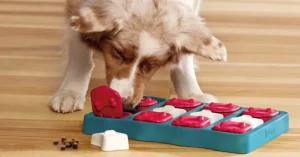
One of the best ways to keep your dog happy is to get them puzzles and toys that they can play with. You can create these toys from everyday items, providing hours of entertainment for kids. You can get your dog to use their nose and brain to find the treats by putting them in a plastic bottle with holes or making a snuffle mat out of fabric strips. They will keep your dog busy. You can transform your garden into a thrilling treasure-hunt playroom by adding these toys. Furry Talez advises you to frequently switch up your dog’s toys to keep them interested and give them new tasks.
Constructing Obstacle Course
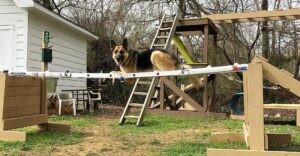
Constructing an obstacle course in your garden is another fantastic idea for keeping your dog occupied. You can make jumps, tunnels, and weave poles from things you find around the house, like hula hoops, pool noodles, and cardboard boxes. Your dog can get better at obedience and agility if you use dog training tricks to help them get through the course. This strengthens your relationship with your pet and gives them a relaxing way to get rid of extra energy. DIY dog enrichment activities like this are great for breeds that have a lot of energy and must always be active. Furry Talez advises pet owners to change the course plan frequently to keep their pets interested and challenged.
Note: There might be affiliate links mentioned here. We may receive a commission if you purchase a product through an affiliate link. There is no additional charge for you. Please do your own research before making any online
Sensory Gardens
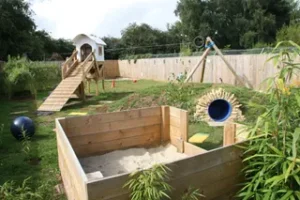
A sensory garden is a great way to keep your dog’s body and mind busy. Planting a variety of dog-friendly herbs and flowers, such as mint, lavender, and rosemary, can offer them a delightful array of flavours and aromas. You can create a stimulating environment by incorporating elements like digging sand pits, splashing water features, and contrasting textures such as grass and gravel. Anyone can make these “DIY dog enrichment activities” in their yard in no time. They give dogs lots of chances to play and explore. Furry Talez emphasizes the importance of selecting safe plants and items for your dog’s sensory garden.
Water Play Areas
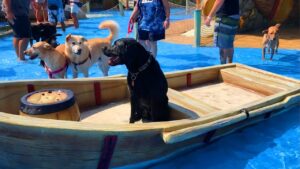
Water is great to add to your backyard entertainment setup because many dogs love to play with it. On hot days, simple water activities like making a splash pad, setting up a baby pool, or using sprinklers can keep kids entertained for hours. The DIY dog enrichment activities listed below are excellent ways to keep your dog cool and give them a great way to play. Water toys that float or squirt can add extra fun. Furry Talez experts say you should always watch your dog play in the water to ensure their safety and avoid mistakes.
Hide and Seek Games
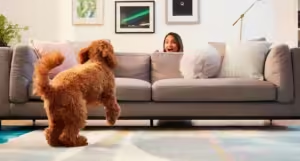
Playing hide-and-seek with your dog is a great way to tap into their innate hunting abilities. Tell your dog to find their favorite toys or treats hidden around the yard. It’s possible to make this game harder by making it harder to hide each time. Before letting your dog look, using dog training tricks like sit and stay can make the game more like obedience. These DIY dog enrichment activities will keep your dog’s mind active, helping it focus and learn how to solve problems. Furry Talez shows how important it is to keep the game fun and satisfying by giving your dog treats or praise.
Statistical Data on Dog Enrichment activities
| Activity Type | Benefits | Statistics |
|---|---|---|
| Sniff Walks | Reduces anxiety, boredom | 40% increase in mental stimulation |
| Agility Courses | Improves agility, reduces hyperactivity | 30% more active dogs |
| Puzzle Toys | Enhances cognitive skills | 25% decrease in destructive behavior |
| Interactive Games | Strengthens bond, provides exercise | 35% happier dogs |
Conclusion
It’s important for your dog’s health and happiness to keep them busy. Make your backyard into a fun and useful place by using your imagination.There are many options, like sensory gardening, water play areas, interactive toys, and obstacle courses. There are a lot of “do-it-yourself dog enrichment activities” that can help you bond with your pet. Contact Furry Talez experts who aim to help pet owners give their pets enjoyable and fulfilling experiences. If you use these ideas for fun things to do, your pet will enjoy their garden even more.
Disclaimer: The information provided in this article is for educational purposes only and should not be considered as a substitute for medical advice. Consult a registered Veterinary practitioner before using or trying any product suggested here in this article.
FAQs
What are some simple DIY dog enrichment activities?
Try creating obstacle courses, using treat-dispensing toys, or setting up a digging box in your backyard.
How do I make my backyard fun for my dog?
Incorporate a variety of activities like agility courses, water play areas, and sensory gardens to keep your dog entertained.
Are DIY dog enrichment activities safe?
Yes, as long as you use pet-safe materials and supervise your dog during play to ensure their safety.
Can enrichment activities help with my dog’s behavior?
Absolutely, enrichment activities can reduce boredom and anxiety, leading to better behavior and a happier dog.
What materials do I need for DIY dog toys?
You can use everyday items like PVC pipes, old towels, and tennis balls to create fun and engaging toys for your dog.
Our pets are the cutest parts of our own families, and we love them dearly. As pet parents, we’re always on the lookout for new ways to enrich our pets’ lives so that they may relax, have fun, and feel cherished.
Table of Contents
Introduction
Do-it-yourself pet crafts are a great way to spend quality time with your pets while also providing them with unique, personalized items. In this all-inclusive manual, we’ll delve into the fascinating world of do-it-yourself pet projects, giving you the knowledge, inspiration, and know-how to make a wide variety of items for your pets, from beds to toys.
Advantages of DIY Accessories And Toys For Pets
DIY pet projects are becoming increasingly popular as a fun way for pet owners to bond with their pets and express their individuality. These initiatives go far beyond simple handiwork, as they provide a wealth of benefits that improve the quality of life for both pets and their human caretakers.
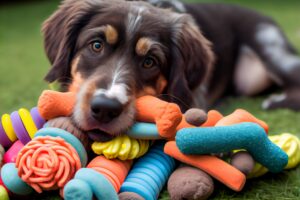
Strengthens Relationship
The ability of DIY pet projects to strengthen the link between owners and their furry companions is one of their most remarkable benefits. Our pets offer us endless amounts of affection and company. DIY accessories and toys are a wonderful way to show your pet how much you care by devoting time, energy, and emotion to the project.
DIY projects are designed and crafted with your pet’s individual likes, dislikes, habits, and needs in mind. This kind of dedication helps you learn more about your pet’s personality and improves the bond between the two of you. By taking the time to make special beds or toys for your pet, you are showing them just how much you care.
Freedom to Personalize to Your Pet’s Preferences
Every pet has a distinct personality with different preferences and character traits. Mass-produced pet supplies and toys may not always meet your pet’s needs or interests, leaving them unfulfilled. DIY pet projects give you the freedom to make unique, personalized products that will appeal to your pet on a deeper level.
If you have a dog with a strong bite, for instance, you can give it toys that are built to last. To satisfy your cat’s natural hunting instincts, you might make them toys that move like their prey. When you take the time to observe your pet’s habits and incorporate those observations into your DIY projects, you give them a level of happiness that can’t be found in mass-produced goods.
Easy on Wallet & Easy on Environment
DIY pet projects are a great way to save money without sacrificing quality or enjoyment in a world where consumerism frequently leads to excessive expenditure. Making your own pet supplies and toys can save you a lot of money compared to buying them in stores. You can make creative and useful DIY projects for your pet out of everyday materials like fabric, cardboard, rope, and even discarded household goods.
Furthermore, the eco-friendly nature of DIY pet projects fits perfectly with the expanding consciousness of environmental responsibility. Reusing items that would have been thrown away is an easy way to lessen your impact on the environment. Taking such eco-friendly measures is not only good for the world but also an excellent example of responsible consumption.
Uncovers Your Creative Abilities
Making your own DIY pet projects is a great way to express your individuality and tap into your inner creativity. You can exercise your creativity and hone your craft abilities by making items for your pet out of materials with a wide range of textures, colors, and patterns. You’ll discover fulfillment in the act of giving form to your ideas as you play around with various mediums and approaches.
The act of creation is very satisfying, whether you’re making a soft bed, a colorful collar, or a challenging puzzle toy. Making something beautiful and useful for your pet while relieving stress is a double win on this creative path.
Understanding Your Pet’s Needs
Knowing your pet inside and out is the bedrock of any successful DIY pet project. Before you start making custom accessories and toys for your pet, it’s important to get to know their individual likes, dislikes, and habits. The way in which a pet interacts with the world depends on their unique personality and qualities. With this knowledge in hand, you can design products to meet the needs of your target demographic and give them a positive, satisfying experience.
Different Ways of Playing

Like people, pets have a wide range of interests and play styles that shape how they engage with toys and equipment. Depending on the breed, some pets are “chewers,” while others are “fetch enthusiasts” or “puzzle solvers.” Observing your pet at play can give you insight into their preferred activities and movements, allowing you to tailor your DIY projects to their inclinations.
Toys designed for chewers, for example, would benefit from tough, durable materials, while a ball designed for intense games of fetch would be different. When you modify your creations such that they fit in with your pet’s personality, you not only increase their enjoyment but also improve their health and happiness.
Chewing Habits and Durability
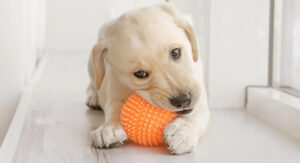
Dogs, in particular, have a hardwired need to chew on things; therefore, it’s important to learn how often your dog chews. To avoid harmful chewing on furniture or shoes, it is important to give dogs healthy alternatives for exploring their environment with their mouths.
- When making chew toys, it’s important to use components that are both non-toxic and sturdy enough to hold up under repeated use.
Scratching is an instinctual action for cats that serves numerous functions, such as nail maintenance and territorial marking.
- To satisfy your cat’s scratching needs without causing damage to your furniture, consider making DIY projects out of cardboard or other materials.
Different Tendencies of Different Breeds
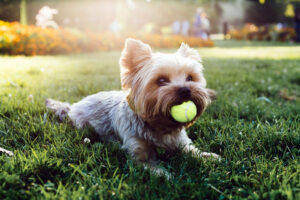
The genetic make-up and historical function of various pet breeds play a part in shaping their unique qualities and tendencies. Finding out as much as you can about the breed of your pet is essential. Some dog breeds, such as terriers and herding dogs, may be predisposed to engage in certain activities.
Preventive Measures for Health Issues
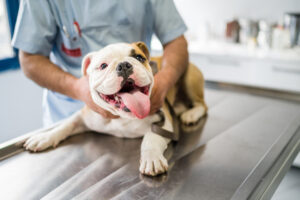
There is a correlation between the prevalence of a disease and the dog’s breed. Knowing about these weaknesses will help you protect them. Pets with breathing problems, for instance, could want bedding with plenty of ventilation, while those with joint concerns could use something more cushioned and supportive.
Protection From Allergies and Sensitivities
It’s not just people who can acquire allergies or sensitivities to particular materials or substances; pets can, too. It is important to use hypoallergenic and pet-safe materials for any homemade pet projects you undertake. The use of potentially allergenic dyes, paints, or fabrics should be avoided.
Talk to your vet before beginning any DIY pet projects. If your pet has allergies, sensitivities, or a history of unpleasant responses to certain materials. They may advise you on safe materials to use and instruct you on how to make objects that won’t harm your pet.
Making DIY Accessories for Pets
Our pets are members of our families and deserve the same level of care and consideration we give to young ones. Making your own pet accessories is a great way to show your pet some love and show off your creativity while also giving your pet a sense of security and individuality.
In this article, we’ll go over some of the ways you can make your pet’s life better, from the collar they wear to the bed they sleep in.
Collars and Leashes
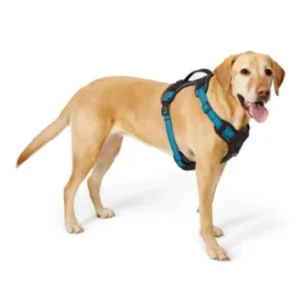
Collars and leashes are more than simple necessities; they can serve as a form of self-expression. Making your pet’s collar and leash yourself provides a unique opportunity to express your creativity while also keeping them secure.
- Start with a sturdy fabric like nylon or leather to make a collar that will last and still look great.
- Use your pet’s name, their favorite color, or even ornamental components like studs or charms to personalize the piece.
- Make sure the materials you use won’t harm them or cause skin irritation.
- Measure your pet’s neck to find the best possible fit, allowing for some wiggle room.
- Braiding many fabrics together creates a distinctive look for leashes, and you may add a comfortable handle for convenient use.
- When going for a walk at night, it’s a good idea to have some reflective or glow-in-the-dark accessories.
Creating a unique collar and leash for your pet is a great way to show off your design skills and make sure they stay safe and secure on walks in the park.
Cozy Blankets and Sheets

Just like us, pets benefit from having a warm and welcoming space to relax in. Create a relaxing space for your pet to rest and rejuvenate by making their own blankets and beds.
- To get started, use comfortable, easily cleaned textiles.
- Pick designs and hues that complement both your pet’s tastes and the style of your home.
- Create a bed with a zippered, removable cover so it can be easily washed.
- You may get the most comfort out of your bed by stuffing it with foam or old pillows.
- Cutting and stitching together layers of fleece or other soft fabrics can suffice to create a blanket.
- Blankets can be used year-round for portable warmth and comfort, not only in the winter.
- The blanket can be made even more special by adding your pet’s name or a pawprint pattern.
Fashionable Cloths

Your furry friend can be just as fashionable as you are! Making your own pet clothes is a fun way to express your individuality and put your pet in the spotlight.
- Consider your pet’s movement and comfort before putting together any costumes.
- Pick loose, comfortable clothing made of breathable materials.
- To prevent your pet from choking, take precise measurements and forego any extra trimmings or decorations.
- Costumes with a specific theme can be made with simple sewing abilities and worn on special occasions or holidays.
- Your pet can become the center of attention with the help of a superhero cape, a party hat, or a tutu skirt.
- Always keep an eye on your pet while they’re dressed to make sure they’re comfortable
Creating Feeding Stations
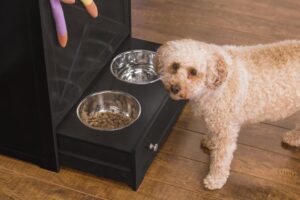
Making a well-designed feeding station for your pet will help them maintain a healthier posture and digestive system during one of the most important parts of their day.
Pets with joint issues or those that are overweight can greatly benefit from elevated feeding stations. Repurposed materials like wood or plastic can be used to make one.
- Make sure your pet’s neck and back don’t get strained by designing a raised platform with bowls at a reasonable height.
- Think about installing shelves or drawers to keep snacks neatly stashed and within easy reach.
- Hygiene must be a top priority when designing feeding stations. To protect your pet’s health, choose wipeable or washable fabrics.
- Keep the feeding station in good working order by checking it for damage and wear on a regular basis.
Note: There might be affiliate links mentioned here. We may receive a commission if you purchase a product through an affiliate link. There is no additional charge for you. Please do your own research before making any online purchases.
Making DIY Toys For Pets
Our pet’s playtime is crucial to the health of both their body and mind. Making DIY toys for pets is a fun and creative way to bond with your four-legged pals while also providing them with hours of enjoyment. These one-of-a-kind items, from games to feather wands, are designed to satisfy your pet’s innate curiosity while strengthening the bond between you and your furry friend.
Puzzle Toys

Pets, just like us, greatly benefit from mental challenge and problem-solving in the form of challenging puzzles and games.
Treat-dispensing interactive puzzle toys are a fun way to test your pet’s intelligence while also encouraging positive behaviors.
- DIY puzzle toys can be made from any box or container with a lid.
- Create access to the delicacies within by cutting holes in the covers. Put some food or treats in the container, and let your pet figure out how to get them.
- This serves multiple purposes, including providing mental stimulation and warding off boredom-related bingeing.
You may tailor the puzzle’s challenge to your pet’s skill level. To keep them interested and puzzled as they progress in skill, you can tweak and improve the design.
Rope Toys for Dogs

Chewing and tug-of-war games are two of a dog’s favorite activities. Making your own rope toys is a great way to redirect their energy and have fun while doing it.
- Produce braided toys that are simple to hold and chew using all-natural, non-toxic materials like cotton rope.
- Depending on your dog’s preferences, you can try out different knot patterns and sizes.
- Make sure the rope is well braided and free of any slack that could cause suffocation.
Chewing on the rope prevents plaque and tartar from accumulating in the teeth.
Tug-of-war activities with the rope toy are great for your dog’s physical health and for strengthening your bond with your canine companion.
Feather Wands and Laser Pointers for Cats
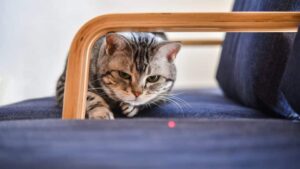
Our feline friends can’t be truly happy or pleased until they are able to indulge their natural hunting impulses. Feather wands and laser pointers that you make yourself are fascinating ways to play with your cat.
- Feathers and a thread or bendable stick are all you need to make a wand.
- Feathers should move to attract cats, and when they swat at them, it will remind them of hunting.
Your cat will greatly benefit from the physical exercise and the opportunity to engage in natural behaviors in a fun and safe setting that this form of play affords.
Cats can also have fun with laser pointers, which are a common interactive toy. The flickering light simulates the actions of small prey, arousing your cat’s natural hunting instincts.
Caution: Never point the laser at your cat’s eyes, since this could cause permanent damage
Cardboard Caves for Cats
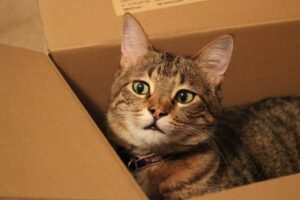
Cats are well-known for their curious nature and penchant for finding new places to hide. Cardboard caves are an easy and inexpensive way to satisfy this feline passion.
- Collect a wide range of cardboard box sizes and shapes.
- Create passageways and storage areas by cutting holes in the boxes at regular intervals.
- In order to avoid injury, the cardboard’s edges should be smooth and unbroken.
- Cat-friendly patterns and themes can be used to further customize the hiding places.
These nooks are perfect for your feline friend to investigate, play in, and rest in. Cardboard’s rough surface is ideal for scratching, promoting healthy claws, and reducing the risk of damage to your furniture.
Tips for Successful DIY Pet Projects
DIY pet projects are fun and educational for you and your furry friend. Crafting your pet’s own unique accessories and toys can be a lot of fun, but before you get started, there are a few things you should know to make sure your pet is safe, happy, and healthy.
Incorporating these principles into your DIY pet projects can ensure that the final products are both useful and enjoyable for your pet.

Prioritize Your Pet’s Health and Safety
When making DIY toys for pets, you should always put their safety first.
- Select components that are harmless to your pet’s health and won’t cause any allergic reactions.
- Pets typically investigate new objects by putting them in their mouths, so it’s best to steer clear of anything toxic that they could eat.
- Make sure any decorations or embellishments you use aren’t readily chewed off and swallowed if you want to use them.
- If you have a little pet or one that likes to chew, you should be extra wary of toys with small, removable elements that could present a choking hazard.
Choose High-Quality and Long-Lasting Materials
The durability and security of the things you make depend on your material choices. Pick high-quality, long-lasting materials that can handle your pet’s rough play style.
- Fabrics made from natural materials like cotton, hemp, or fleece are ideal because they are soft on your pet’s skin and won’t harm them in any way.
- Choose organic colors and paints that won’t off-gas dangerous chemicals when decorating with pets.
- Don’t use anything if there’s a chance it could irritate your pet or if you have allergies.
- In addition, if you plan on using adhesives, double check that they are safe for your pet and will effectively bond the materials.
Proportions and Measurements
Your pet may feel uncomfortable or possibly be put in danger by objects that are too big or too small for them. Make sure the DIY toys for pets are in the right measurements for your pet. A toy that is too small for your dog could cause choking, while DIY accessories that are too large could restrict your pet’s movement or cause discomfort.
- Make sure your pet’s collar or harness fits properly so it doesn’t restrict movement or cause skin irritation.
- Think about how your pet grips, chews, and plays with toys.
- It’s better to overestimate the item’s size and compatibility than underestimate it when introducing it to your pet.
Make Your Pets Happy with Tactile Stimulation
Making DIY toys for pets that stimulate your pet’s senses and interest them is a rewarding aspect of DIY pet projects. Tactile stimulation can be achieved by the use of a variety of textures, including but not limited to smooth surfaces, soft textiles, and crinkly materials.
- To create visual and auditory appeal that catches your pet’s attention, consider giving toys with bells, squeakers, or rattles.
- Use natural scents like lavender or catnip to pique your dog’s or cat’s interest, and vice versa.
Your pet will be more engaged and have more fun during playtime with sensory-rich accessories and toys because they are satisfying their natural impulses.
Always Ensure Safety Through Supervision
Even if you made these items with your pet’s delight in mind, you still need to keep an eye on them while they play.
- Keep an eye on your pet’s behavior as you introduce him or her to new toys or accessories.
- You can gauge their reaction and make sure the toys are suitable for their age and preferred method of play by letting them try them out first.
- Check the condition of your pet’s toys and accessories on a consistent basis. Things wear out, lose their strength, or come loose with time, posing hazards to your pet.
- Maintain a risk-free recreational space by fixing or replacing damaged components immediately.
Customize Your DIY Pet Projects
The individuality of each pet is reflected in its individual tastes and habits. Keep an eye on how your pet uses your creations and be willing to make changes based on their suggestions. Some animals are more interested in particular sorts of play, while others have a preference for particular textures.
- Keep an eye on how your pet responds and modify your DIY project plans accordingly.
- This customization not only increases your pet’s satisfaction but also strengthens your relationship with them as you meet their specific demands.
FAQs
Why should I try making DIY pet projects?
DIY accessories and toys for your pets are a great way to bond, show them you care, and have fun while doing something productive and creative. You may save money, help the environment, and exercise your imagination all at the same time with one of these projects.
How can I use DIY pet projects to strengthen my bond with my pet?
Making DIY accessories and toys for your pets reflects your attention to their individuality and requirements. It is a great way to strengthen your bond with them. The emotional connection you share with your animal buddy will grow as a result of the time, effort, and love you put into crafting for them.
What kinds of pets can benefit from DIY projects?
All sorts of animals, from canines and felines to birds, bunnies, and even small rodents, can benefit from your DIY pet projects. The trick is to learn your pet’s unique wants, needs, and habits, then adapt your work to suit them.
How can I know if the DIY projects I make are secure for my pet?
Make safety a top priority by selecting materials that are safe for pets. Choose eco-friendly materials like wool and cotton and organic paints and dyes. All decorative features should be securely fastened, and small, removable portions should be avoided to prevent choking.
Can you recommend some DIY accessories for pets?
Collars, leashes, beds, blankets, clothes, and feeding stations can all be made to order. These items are great for your pet’s comfort and also show off their unique individuality.
When making homemade DIY accessories for pets, how do I determine the appropriate dimensions?
Consider your pet’s breed, size, and comfort level while making your selection. Overly large or small items might cause discomfort or restrict movement, respectively. To avoid any pain or safety concerns, make sure you measure your pet correctly.
What positive effects might DIY toys for pets have on my pet’s health and happiness?
DIY toys for pets, including puzzles and toys you can climb on, are great for your pet’s development. These playthings satisfy your pet’s innate drives, stave off boredom, and improve their well-being.
How can I make sure the DIY projects I make for my cats won’t hurt them?
Always put safety first while making DIY toys for pets. Materials should be natural, non-toxic, and durable enough to endure your pet’s rough playstyle. Don’t use anything that could break off and pose a choking danger. Toys should be checked for damage and replaced on a regular basis.
How can I make DIY toys for pets more interesting and engaging?
You may make toys that your pet enjoys more by paying attention to how they play with the ones you make for them. See how your pet responds before making any permanent changes to the colors, shapes, or interactivity. Toys that are special to pets increase their interest in and satisfaction from play.
What are some additional tips for completing DIY pet projects successfully?
Don’t forget to engage the senses by mixing up the textures and aromas. When playing with a new toy, always keep an eye on your pet. Don’t be afraid to make changes or additions if your pet suggests it. Last but not least, have fun making things and watching your pet have fun with them.
Conclusion
DIY pet projects are a satisfying way to exercise your ingenuity while also improving your pet’s quality of life. By learning your pet’s likes and dislikes, you may make him or her unique accessories and toys that will bring you both comfort and pleasure. DIY projects for pets require careful planning, original thinking, and an in-depth familiarity with your furry friend’s individual needs. Put in some elbow grease, round up some supplies, and go out on a voyage of making precious memories with your beloved friends.
A day excursion or lengthy stroll with your dog may be a lot of fun. On the other hand, you should keep your dog active, happy, and healthy on these journeys. Providing children with nutritious snacks is one approach. In this manual, you will learn how to pack nutritious snacks for your canine, such as fresh produce and other delectable goodies.
To maintain good health and plenty of energy, dogs, like people, require a balanced diet. Be sure to pack nutritious food for your dog when you go on a day vacation so it can eat while you’re away. Various nutritious snack options for dog health, along with their advantages and preparation methods, are detailed in this guide.
Table of Contents
Advantages of Pure Fruits
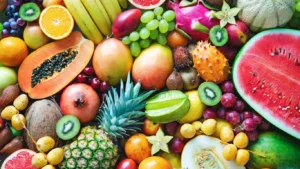
Fresh fruits’ antioxidants, vitamins, and fiber are still hard to beat. Your dog nutrition is important for their whole health, which also provides them with energy and a robust immune system.
Canine-Friendly Fruits
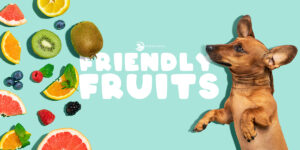
Dog nutrition requirements can be met by eating bananas, apple slices (with the peel still on), blueberries, strawberries, and melons. Not only are these fruits delicious, but they are also nutrient-dense. For instance:
- Bananas are rich in vitamin B6 and potassium.
- You can get vitamin C, fiber, and vitamin A daily from just a few apple slices.
- In blueberries, you’ll find a ton of vitamins.
- You may get your daily dose of vitamin C and fiber from berries.
- Hydration is key, and melons are a great source of vitamins A and C.
Fruits to Avoid
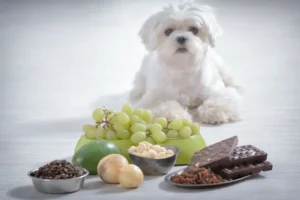
Even though many fruits are healthy for humans, it’s crucial that your dog not eat grapes or raisins since they are toxic. To avoid making your pet sick, it’s best to introduce new meals slowly.
Advantages of Raw Vegetables for dog diet
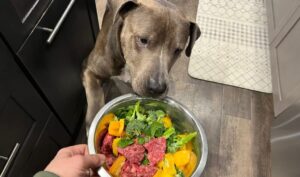
Vegetables are an excellent dietary choice because they contain vitamins, minerals, and fiber. By feeding vegetables as a dog diet, you can help its digestive system and provide it with essential nutrients.
Safe Vegetables for Dogs
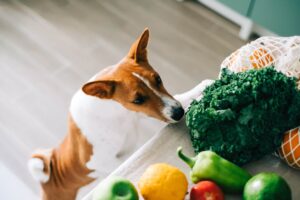
Eating carrots, kale, potatoes, bell peppers, and squash is okay. Your dog will benefit from them because:
- Eat carrots cooked or raw; the choice is yours. Both beta-carotene and fiber abound in them.
- To create kale chips, bake the kale with a drizzle of olive oil and a pinch of salt.
- Kids can eat cooked potatoes and squash without fear of choking.
- The vitamin A and vitamin C content of bell peppers is high.
Vegetables to Avoid

The one vegetable that dogs are off-limits to is onion, in any form. In addition to making dogs nauseous, onions can cause additional symptoms of illness.
Adding Peanut Butter to your dog’s diet
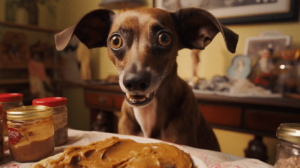
Peanut butter is full of healthy fats and energy; many dogs adore it. It may also be a fun and engaging way to keep your mind busy when used to fill toys like Kongs.
How to Use Peanut Butter Toys?
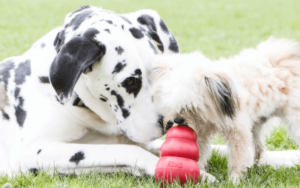
Your dog will be satisfied and occupied with this. Toys like Kongs can be filled with peanut butter. If you want your treat to last longer, freeze the entire toy. The canine sugar xylitol should not be in the peanut butter.
Note: There might be affiliate links mentioned here. We may receive a commission if you purchase a product through an affiliate link. There is no additional charge for you. Please do your own research before making any online
What are the Benefits of Making Your Homemade Sweets?
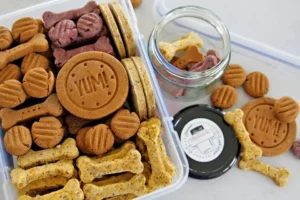
When you create your dog’s treats yourself for improving dog energy levels, you can control what goes into them, ensuring your dog only gets the best. Some commercially available sweets include chemicals and additives that you may want to avoid.
Common Dishes for changing your dogs taste
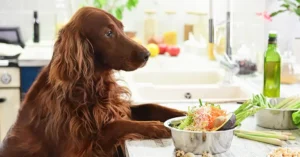
Lets know few dishes for changing dogs taste:
Banana and Peanut Butter Bites: After filling molds with peanut butter and mashed banana, freeze the delights.
Apple and Carrot Bites: Combine the grated carrot and apple with the oat flour. Form the dough into little balls and put them in the oven.
Sweets Made with Pumpkin and Yogurt: Fill molds with plain yogurt and combine with canned pumpkin. Chill the sweets.
Selecting Appropriate Delights
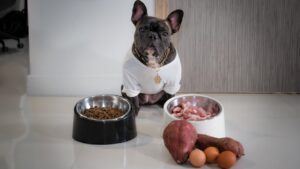
Healthy store-bought snacks are a great alternative to making snacks if you’re short on time. Treats should contain no artificial flavors or colors, only natural ingredients.
Recommended Brands
Names like “Super Smarty Hearties” come highly recommended. Omega-3 fatty acids, which are present in these tasty snacks, aid in edema reduction and contribute to overall joint health.
Importance of Hydration for dogs
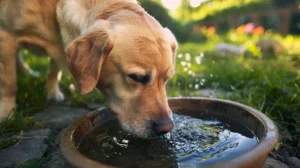
Give your dog nourishing dog snack ingredients and make sure it drinks enough water, especially on hot days or after long walks. Your health might take a serious hit if you get dehydrated.
Tips for Keeping Your Dog Hydrated
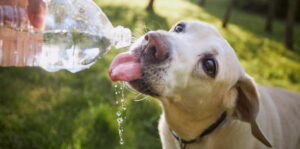
You and your canine should always go with water. You may pack a collapsible water bowl to make things easier for your dog. If your dog is active, make sure to give it water often.
Providing snacks in proportion
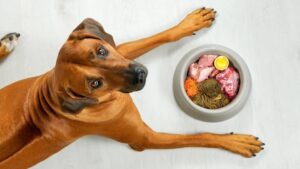
Even nutritious active dog snacks might contribute to weight gain if consumed in excess. To prevent your dog from gaining weight unhealthily, it is important to watch its portion quantities.
How to Determine the Right Amount of Treats for your dog?

To determine the appropriate amount of treats for your dog, consider their age, size, and amount of exercise. How much food is right for your dog? Consult your vet to know the best dog exercise.
Conclusion
You can keep your dog active and healthy even on the run with the correct treats. You should also keep a note on your dog food allergies items to keep those away from it. They can get the nutrition and energy they need from fresh produce, peanut butter-filled toys, and nutritious snacks from the grocery store. Make sure your furry friend stays happy and energized on their trips by giving them healthy snacks from FurryTalez. Be careful to offer the snacks in the correct quantity and ensure they are healthy. Following these suggestions, you and your four-legged buddy can enjoy many enjoyable and beneficial journeys together. Contact with FurryTalez today for your furry friend.
FAQS
What are some healthy snacks for dogs on the go?
Healthy snacks for dogs on the go include carrots, apple slices (without seeds), blueberries, sweet potato treats, and small pieces of lean meat. These snacks provide essential nutrients and energy while being easy to carry.
Are there any snacks I should avoid giving my dog while traveling?
Yes, you should avoid giving your dog snacks that are high in fat, sugar, or salt, such as processed human foods, chocolate, grapes, raisins, and anything with artificial sweeteners like xylitol. These can be harmful to your dog’s health.
How can I ensure my dog stays hydrated while we’re on the go?
To keep your dog hydrated, always carry a portable water bottle and collapsible bowl. Offer water regularly, especially after physical activity or in hot weather, to prevent dehydration.
Can homemade snacks be a good option for travel?
Absolutely! Homemade snacks like baked sweet potato chips, dehydrated meat strips, or simple dog biscuits can be healthy and convenient options for travel. Just ensure they are stored properly to stay fresh.
How often should I give my dog snacks while traveling?
Offer snacks in moderation, considering your dog’s size, activity level, and overall diet. Small, frequent snacks can keep your dog energized without overfeeding. Always balance snacks with regular meals and exercise.





